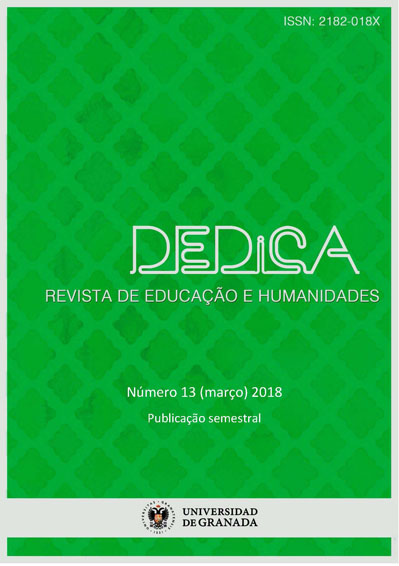String sight reading in Music Education
DOI:
https://doi.org/10.30827/dreh.v0i13.7247Keywords:
sight-reading, string instruments, music education, sight-reading testAbstract
The purpose of this paper is to know how the string sight-reading is nowadays being practiced and being taught in the Spanish music education system. The relation between the use of sight-reading tests in exams and the previous preparation of students to succeed, is being analyzed.
Studies in different fields of sight-reading are reviewed as well as conservatory study plans and Spanish regulations, in the different regions, about sight-reading planification and exams. The English system, ABRSM has been studied to establish a comparison with Spanish music education system approach. The results hold up the sight-reading as an indicative factor in the music education system approach and also a rating factor of musician’s aptitudes, training typology and experience in performance field.
Downloads
References
Alexander, M. L.; Henry, M. L. (2012). The Development of a String Sight-Reading Pitch Skill Hierarchy. Journal of Research in Music
Education, 60(2), pp. 201-216.
Boyle, J. D. (1970). The effect of prescribed rhythmical movements on the ability to read music at sight. Journal of Research in Music Education, 18(4), 307–318.
Elliott, C. (1982). The Relationships among Instrumental Sight-Reading Ability and Seven Selected Predictor Variables. Journal of Research in Music Education, 30(1), 5.
Freeman, J. (2008). Extreme sight-reading, mediated expression, and audience participation: Real-time music notation in live performance. Computer Music Journal, 32(3), 25–41.
Gabrielsson, A. (1999). The Performance of Music. The Psychology of Music, 2, 501–602.
García Gallardo, C. L. (1997). La lectura musical en las primeras fases del aprendizaje del instrumento. Música y Educación, 30(junio), 71–82.
Goolsby, T. W. (1994). Eye Movement in Music Reading: Effects of Reading Ability, Notational Complexity, and Encounters. Music Perception: An Interdisciplinary Journal, 12(1), 77–96.
Gordon, E. (1967). The Musical Aptitude Profile. Music Educators Journal, 53(6), 52.
Grutzmacher, P. A. (1987). The Effect of Tonal Pattern Training on the Aural Perception, Reading Recognition, and Melodic Sight-Reading Achievement of First-Year Instrumental Music Students. Journal of Research in Music Education, 35(3), 171.
Gudmundsdottir, H. R. (2010). Advances in music-reading research. Music Education Research, 12(4), 331–338.
Hayward, C. M.; Eastlund Gromko, J. (2009). Relationships among music sight-reading and technical proficiency, spatial visualization, and aural discrimination. Journal of Research in Music Education, 57(1), 26–36.
Henry, M. L. (2008). The Use of Specific Practice and Performance Strategies in Sight-Singing Instruction. Update - Applications of Research in Music Education, 26(2), 11–16.
Herrero, L.; Carriedo, N. (2012). Memoria Operativa y Lectura Musical a Primera Vista. Editorial Académica Española. Recuperado de: https://teeenreads.cf/main/ebooks-free-download-fb2-memoria-operativa-y-lectura-musical-a-primera-vista-3847357409-by-laura-herrero-nuria-carriedo-epub.html
Jiménez Alegre, M. Á. (2008). Miguel Ángel Jiménez Alegre. Efectos de la deprivación visual y auditiva en la lectura a primera vista en el piano en tres tipos de lenguaje musical. Revista Musical Chilena, 62(210), 92–96.
Killian, J. N.; Henry, M. L. (2005). A Comparison of Successful and Unsuccessful Strategies in Individual Sight-Singing Preparation and Performance. Journal of Research in Music Education, 53(1), 51–65.
Kopiez, R.; Lee, J. I. (2008). Towards a general model of skills involved in sight reading music. Music Education Research, 10(1), 41–62.
Kopiez, R.; Weihs, C.; Ligges, U. & Lee, J. I. (2006). Classification of high and low achievers in a music sight- reading task. Psychology of Music, 34(1), 5–26.
Lehmann, A. C.; Ericsson, K. A. (1996). Performance without preparation: Structure and acquisition of expert sight-reading and accompanying performance. Psychomusicology: A Journal of Research in Music Cognition, 15(1–2), 1–29.
McPherson, G. E. (1995). Five aspects of musical performance and their correlates. Bulletin of the Council for Research in Music Education 127, 115-21.
McPherson, G. E. (2006). Self-efficacy and music performance. Psychology of Music, 34(3), 322–336. https://doi.org/10.1177/0305735606064841
McPherson, G. E.; Gabrielsson, A. (2002). From sound to sight. Part of The science and psychology of music performance. Creative strategies for teaching and learning, ed. R. Parncutt and G. E. McPherson, 99-115. Oxford, UK: Oxford University Press.
Mishra, J. (2016). Rhythmic and melodic sight-reading interventions: Two meta-analyses. Psychology of Music, 44(5), 1082–1094.
Mishra, J. (2014). Factors Related to Sight- Reading Accuracy: A Meta- Analysis. Journal of Research in Music Education, 61(4), 452–465.
Molina, E. (2003). La lectura a primera vista y el análisis. Música y Educación, 16(2), Núm. 54, p. 73-90.
Monferrer Montañés, A. (2016). Primera vista en el piano en las enseñanzas elementales. TFM en Didáctica de la Música. Castellón: Universitat Jaume I. (Documento no publicado).
Núñez, G.; Tejada, J. (2012). Lectura musical y procesos cognitivos implicados. Revista Electrónica LEEME, 29, (Junio 2012), pp.56-82.
Parncutt,R.; McPherson, G. (2002). The science and psychology of music performance: Creative strategies for teaching and learning. Oxford: University Press.
Saxon, K. (2009). The Science of Sight Reading. American Music Teacher, 58(6), 22–25.
Schon, D.; Anton, J. L.; Roth, M. & Besson, M. (2002). An fMRI study of music sight-reading. Neuroreport, 13(17), 2285–2289.
Schön, D.; Anton, J. L.; Roth, M. & Besson, M. (2002). Ovid: Enlace externo. NeuroReport, 13(3), 2285–2289.
Segalerba, M. G. (2008). Construcción de la representación simbólica en la lectura a primera vista. Actas de la VII Reunión de SACCoM. Sociedad Argentina para las Ciencias Cognitivas de la Música - ISBN 978-987-98750-6-, pp. 229-242.
Sloboda, J. A. (1978). The Psychology of Music Reading. Psychology of Music, 6(2), 3–20.
Sloboda, J. A. (1985). Sight reading. The Musical Mind. Oxford: Science Publications, pp. 68–90.
Thompson, W. B. (1987). Music Sight reading Skill in Flute players. General Psychology, 114(april), 345–352.
Wolf, T. (1976). A cognitive model of musical sight-reading. Journal of Psycholinguistic Research, 5(2), 143–171.
Wurtz, P.; Mueri, R. M. & Wiesendanger, M. (2009). Sight-reading of violinists: Eye movements anticipate the musical flow. Experimental Brain Research, 194(3), 445–450.
Yeomans, E. (1922). Some coments on school music. The journal of Education, 96(8), pp. 208-211.
Zhukov, K. (2005). Good Sight-Readers: Born or Bred? in 7th Australasian Piano Pedagogy Conference. Adelaide (Australia). Recuperado en: http://appca.anu.edu.au/Part 1/Zhukov
Zhukov, K. (2014). Exploring advanced piano students’ approaches to sight-reading. International Journal of Music Education, Online First. doi:10.1177/0255761413517038












